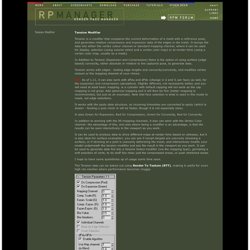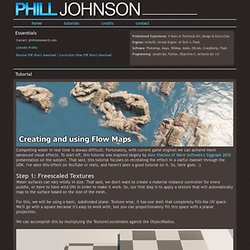

Cubemap Reflections. DepthMasking. Curvature maps/Dirt/Worn. Tension. Tension Modifier Tension is a modifier that compares the current deformation of a mesh with a reference pose, and generates relative compression and expansion data of the edges in the mesh.

It dumps the data into either the vertex colour channel or standard mapping channel, where it can be used for display, selection (using volume select and a vertex color map) or at render-time (using a vertex color map, usually as a mask). In Addition to Tension (Expansion and Compression) there is the option of using surface (edge based) convexity, either absolute or relative to the captured pose, to generate data. Tension works with edges - testing edge lengths and concavity/convexity, and modifies vertex colours or the mapping channel of your choice. NEW As of 1.11, it can also work with dPdu and dPdv (change in U and V, per face) as well, for the expansion and compression calculations. It uses Green for Expansion, Red for Compression, Green for Convexity, Red for Concavity. 3dsmax2012 64 bit Usage:
Fractal Orgy. BETA. Spine-runtimes/spine-unity/Assets/Spine/Shaders/SkeletonLit.shader at master · EsotericSoftware/spine-runtimes. Unity-bowerbird/Shaders at master · omgwtfgames/unity-bowerbird. Shader depth and overlay. Outline shader using Depth of Field. Is there any way to modify matrix of texture in CG? Useful Resources. Phill Johnson. Compelling water in real time is always difficult.

Fortunately, with current game engines we can achieve more advanced visual effects. To start off, this tutorial was inspired largely by Alex Vlachos of Valve Software's Siggraph 2010 presentation on the subject. That said, this tutorial focuses on recreating the effect in a useful manner through the UDK. I've seen this effect on YouTube or reels, and haven't seen a good tutorial on it. So, here goes. :) Step 1: Freescaled Textures Water surfaces can vary wildly in size.
For this, we will be using a basic, subdivided plane. We can accomplish this by multiplying the TextureCoordinates against the ObjectRadius. Step 2: Set Up Panning & Reset Next, we have to tell the material to move the texture. We can do this by taking the time of the simulation (the Time expression) floating modulus three. Go ahead and set the Panner's X and Y speed to something like 0.2, the texture should be panning up and to the left.
Step 4: Lerp to Hide The Reset. Rendering Water as a Post-process Effect - Graphics Programming and Theory. Water plays an important role in all terrain renderers used in modern games and visualizations to present outdoor areas.

This is because it improves general image quality in an extent bigger than any other technique and makes it more photorealistic. Alas, even though it tends to look better and better with every game released it is still far from being realistic. Besides, deferred shading gains popularity every month. Many newer games and engines make use of it, eg. Starcraft 2 and Tabula Rasa. In this article I will describe a technique of realistic and flexible water rendering by using bump mapping in the post-process stage just after deferred shading. The presented algorithm eliminates the majority of the flaws of typical techniques used for water rendering such as hard edges or unrealistic colour extinction. Theory behind water The theory behind water is very complex and not fully understood. So a completely different solution has to be found. Reflection and refraction Optics.